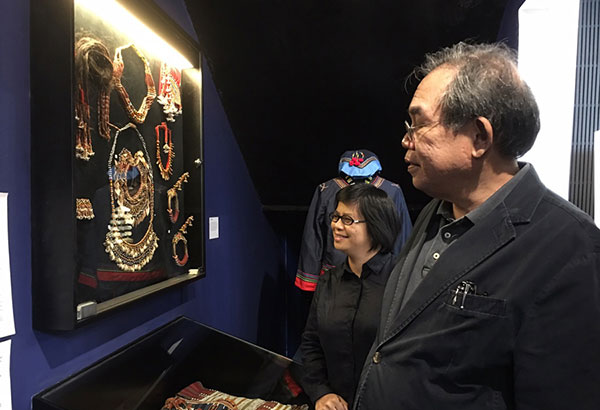A showcase of Cordillera culture

Viewing the exhibits with Dr. Ikin Amores. Photos by JUNE DALISAY
I went up to Baguio a couple of weeks ago to give the commencement address before the Class of 2017 of the University of the Philippines-Baguio (UPB), and began my talk by reminiscing how, as a young boy, “I eagerly anticipated visiting this city, which used to involve a train ride to Damortis, La Union, before transferring to a bus that would wind its way up Naguilian Road. I recall my nostrils tingling when they caught the scent of pine. In high school in the 1960s, Baguio meant the CMLI, Teachers Camp, marching on Session Road to proclaim ‘student power,’ pretty faces from a school called St. Theresa’s, and a dark and exciting place called the Basement — which some of your older teachers might remember.”
You can find the rest of that speech on my blog at www.penmanila.ph — it seems to have acquired a life of its own — but the real highlight of my Baguio sojourn turned out to be a visit to the new Museo Kordilyera on the UPB campus along Gov. Pack Road.
UPB, you have to realize, is unique among UP’s campuses in that it sprawls all over a hilltop, so that anything you build on it has to adapt to its challenging topography. When you think of what the builders of the Rice Terraces had to do, you get an idea of how creative and adaptive UPB’s architects have had to be to maximize the use of its property, keeping aesthetics in mind as well as safety, in this earthquake-troubled city.
UPB Chancellor Ray Rovillos, himself a historian and one of UP’s most capable administrators, had offered to take us on a personal tour of the new museum the day after graduation, and Beng and I happily took him up on it. The three-level Museo looks little more than a glass box with a few exhibits at ground level, but it’s when you take the stairs going underground that your jaw falls at seeing what UPB’s combination of careful scholarship, administrative commitment, and sheer perseverance has produced.
Formally opened last January under the administration of then UP President Fred Pascual, the museum draws on the curatorial work undertaken by Professor Emeritus Delfin Tolentino, Jr., Prof. Victoria Diaz, archivist Cristina Villanueva and museum director Dr. Analyn “Ikin” Salvador-Amores.

The main floor of the Museo Kordilyera
What immediately catches the eye, of course, are the life-size representations of various indigenous people in full tribal dress and gear — so accurately researched, Ikin would tell us, that some people in the community didn’t even know their ancestors had worn them. Going over the intricate weaves and beadwork, Beng and I exchanged stories with Ikin about similar objects we had seen deep in the bowels of Chicago’s Field Museum. While part of the museum’s mission is the visual showcase for the public, an equally important aspect is the scholarly research it hopes to engender. Century-old artifacts are kept in cabinets, yet to be studied, and donations from collectors are welcome to deepen the museum’s holdings.
A Ford Foundation scholar at Oxford University, Ikin had published a landmark study titled Tattooing Ink, Tapping Identities: Tradition and Modernity in Contemporary Kalinga Society, North Luzon, Philippines (Quezon City: UP Press, 2013), the culmination of a long fascination with the practice and origins of tattooing that began with an encounter with an old woman in Baguio’s market almost 30 years ago.
A corner of the museum is devoted to books published by the UP Press and by the Cordillera Studies Center, which has established itself as the most important source of expertise in its area. Prominently displayed are the three excellently written and produced monographs that accompanied the launch and opening exhibits of the Museo Kordilyera: Batok (Tattoos): Body as Archive by Analyn Salvador-Amores; The Indigenous, In Flux: Reconfiguring the Ethnographic Photograph by Roland Rabang; and Jules De Raedt: Life Works, Lived Worlds by Victoria Lourdes C. Diaz. Anyone wanting deeper insights into the ways of the highlands would do well to consult June Prill-Brett’s Tradition and Transformation: Studies on Cordillera Indigenous Culture (Baguio City: Cordillera Studies Center, 2015).
Worthy of commendation for the museum’s modern but welcoming design is architect Aris Go and the 90 Design Studio team that has been helping Chancellor Rovillos and UPB make the most of their limited space — a service Aris has also extended to UPB’s new and handsome Science Research Center, another fine example of environmentally adaptive architecture.
The UPB people were eagerly awaiting the visit of one of the country’s most fervent advocates of indigenous culture and arts, Sen. Loren Legarda, which was planned for mid-July. Knowing the senator’s passion for all things Filipino, I urged Ikin and Chancellor Ray to secure further support from her for the museum and its adjoining auditorium, which will host many conferences on indigenous culture in the years to come.
Besides the ube jam and peanut brittle at Good Shepherd — and, of course, the splendid art exhibits and architecture to be found in the Bencab Museum on Asin Road (Bencab has donated some of his most important pieces to the UPB museum) — Baguio visitors now have another must-see stop on their itinerary. The Museo Kordilyera is open Tuesday-Sunday, 9 a.m. -5 p.m. for a nominal entrance fee. For more information, check out its Facebook page here: https://www.facebook.com/upbmuseokordilyera/.
* * *
Email me at jose@dalisay.ph and visit my blog at www.penmanila.ph.



















